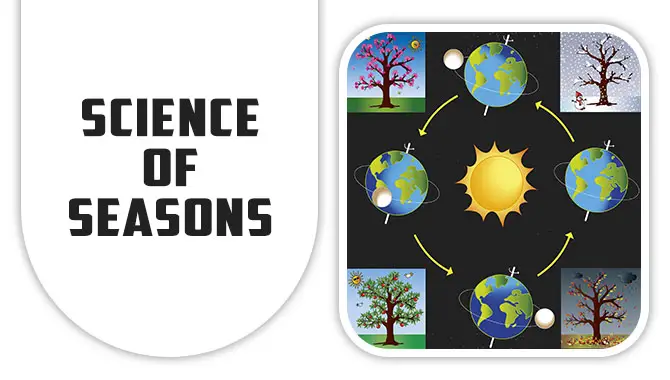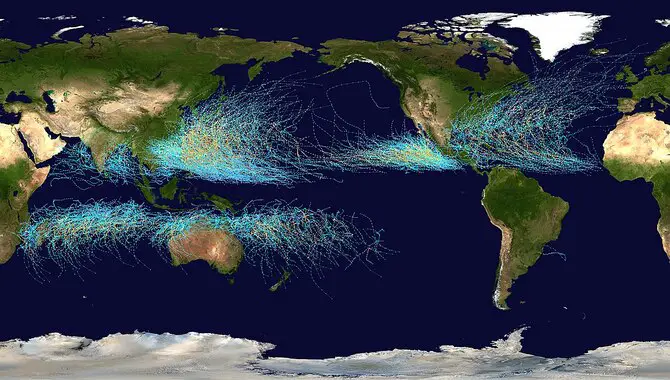Understanding the science of seasons is important for travellers as it facilitates informed decision-making, enhances travel experiences, promotes preparedness, helps manage crowds, and encourages environmental appreciation. Knowing the season’s science helps travellers prepare for the specific weather conditions they are likely to encounter during their trip.
Understanding temperature ranges, precipitation patterns, and potential climate variations empowers travellers to pack appropriate clothing, gear, and essentials. It ensures their comfort and safety throughout their journey. Additionally, the season’s science can play a role in managing crowds and avoiding peak tourism periods. Popular destinations often experience high tourist traffic during certain seasons.
By considering the science behind the changing seasons, travellers can make the most of their journeys and connect with nature. And contribute to sustainable and responsible tourism practices. So without further ado, let’s dive into Understanding the season’s science.

Science Of Seasons You Have To Know As A Traveller

The science of seasons is crucial for travelers for several reasons. Firstly, it allows travelers to plan their trips more effectively and make informed decisions about their destinations and activities. Different seasons offer varying weather conditions, natural phenomena, and cultural events, which can significantly impact the travel experience.
By understanding the season’s science, travellers can choose the most suitable time to visit a particular destination based on their preferences and interests. For example, those seeking warm beach vacations might opt for destinations during the summer season. While winter enthusiasts may plan trips to snowy regions for skiing or winter sports.
The season’s science provides insights into the natural beauty and ecological changes that occur throughout the year. Travellers interested in wildlife, flora, or specific natural phenomena, such as migrations or blooming seasons, can align their travel plans accordingly. This understanding allows them to witness and appreciate the unique wonders that each season brings. So As a traveller, you have to know the season’s science, in this below, we discuss it:
The Earth’s Tilt- A Dance With The Sun

The Earth’s tilt, specifically the tilt of its axis relative to its orbit around the sun, has a significant impact on seasonal changes. This tilt is responsible for the variation in sunlight received by different parts of the planet throughout the year, leading to the distinct seasons we experience.
As the Earth orbits the sun, there are two key positions in its journey: the summer solstice and the winter solstice. The summer solstice occurs when the hemisphere tilts towards the sun. Receiving its most direct sunlight and experiencing the longest day of the year. Conversely, the winter solstice occurs when the hemisphere is tilted away from the sun, resulting in its shortest day and least direct sunlight.
The tilt of the Earth’s axis also affects the distribution of sunlight during the transitional periods of spring and autumn. During these seasons, the tilt is neither directly towards nor away from the sun. Resulting in the equal day and night lengths. This creates milder temperatures compared to the extremes of summer and winter.
The effect of the Earth’s tilt on seasonal changes is most pronounced in the mid-latitudes. Regions closer to the equator experience less variation in sunlight throughout the year and have relatively consistent climates, while areas closer to the poles have more extreme seasonal variations.
This tilt-induced variation in sunlight is crucial for the functioning of ecosystems and the timing of biological processes. It influences plant growth, migration patterns of animals, breeding seasons, and the overall biodiversity of different regions. Additionally, seasonal changes impact human activities such as agriculture, tourism, and recreational pursuits. As communities adapt to the unique characteristics of each season.
Equinoxes- The Balance Points
Equinoxes are significant points in the Earth’s orbit around the Sun that mark the beginning of spring and autumn. During an equinox, which occurs twice a year, the Earth’s axis is neither tilted towards nor away from the Sun. Resulting in roughly equal lengths of day and night across the globe.
The equinoxes have a profound effect on seasonal changes. When the March equinox takes place in the Northern Hemisphere, it signals the start of spring, while in the Southern Hemisphere, it marks the beginning of autumn. Conversely, during the September equinox, the Northern Hemisphere transitions into autumn, while the Southern Hemisphere welcomes the arrival of spring.
The equinoxes are crucial in determining the length of daylight hours. As the Earth orbits the Sun, the tilt of its axis causes the Sun’s rays to strike different parts of the globe at varying angles. This tilt is responsible for the changing seasons. During the equinoxes, however, the Sun’s rays are perpendicular to the Earth’s equator, resulting in an equal distribution of daylight and darkness across the planet.
Equinoxes are also significant for astronomers and those interested in celestial events. During the equinoxes, the Sun rises exactly due east and sets due west. Creating a balanced alignment between Earth and the Sun. This alignment enables accurate determination of cardinal directions and serves as a reference point for various cultural and religious celebrations.
Solstices- Extremes Of Light And Dark
The summer and winter solstices represent the two extreme points in the Earth’s axial tilt. During the summer solstice, the hemisphere tilted towards the Sun experiences its longest day and shortest night, while the opposite hemisphere endures its shortest day and longest night. The reverse occurs during the winter solstice, bringing shorter days and longer nights to the hemisphere tilted away from the Sun.
The Role Of The Sun Illuminating The Seasons

The Sun plays a crucial role in seasonal changes on Earth. These changes are primarily driven by the tilt of Earth’s axis and its orbit around the Sun. The tilt of the Earth’s axis is responsible for the variation in the amount of sunlight different parts of the Earth receive throughout the year, resulting in the four distinct seasons: spring, summer, autumn (fall), and winter.
During the summer season, the hemisphere tilted towards the Sun receives more direct sunlight. The Sun’s rays strike the surface at a higher angle, resulting in more concentrated and intense heat. This leads to warmer temperatures, longer days, and shorter nights. As a result, vegetation flourishes, and animals tend to be more active.
In contrast, during the winter season, the hemisphere tilted away from the Sun receives sunlight at a lower angle. The rays are spread over a larger area, resulting in less concentrated heat. Consequently, temperatures drop, days become shorter, and nights become longer. Many plants enter a dormant state, and animals may go into hibernation or migrate to warmer regions.
The transition between these seasons, known as spring and autumn, occurs when the Earth is in a position where neither hemisphere is tilted towards or away from the Sun. This results in more even distribution of sunlight across both hemispheres, leading to milder temperatures. Spring is characterized by the awakening of plants and the return of many animal species, while autumn brings the shedding of leaves and the preparation for winter.
Sunlight Intensity- Direct Vs. Indirect
The tilt of the Earth’s axis causes the Sun’s rays to strike the surface at varying angles. Resulting in differences in sunlight intensity. During summer, in the hemisphere tilted towards the Sun, sunlight reaches the surface more directly, leading to higher temperatures. Conversely, in winter, sunlight arrives at a shallower angle, spreading its energy over a larger area and resulting in cooler temperatures.
Day Length- The Dance Of Light And Darkness
Seasonal changes also manifest through variations in day length. As the Earth orbits the Sun, different hemispheres receive varying amounts of daylight. Summer brings longer days and shorter nights due to the hemisphere’s greater exposure to sunlight. While winter sees shorter days and longer nights as the hemisphere tilts away from the Sun.
The Impact Of Geography- Regional Nuances In Seasons

The impact of geography is profound and far-reaching, influencing various aspects of our lives and the world around us. Geography refers to the physical features and spatial characteristics of the Earth’s surface, encompassing factors such as landforms, climate patterns, ecosystems, and human settlements.
One of the key impacts of geography is its influence on climate and weather patterns. Factors such as latitude, altitude, and proximity to bodies of water. And prevailing wind patterns all contribute to the diverse climates experienced in different regions.
These climate variations, in turn, affect agricultural practices, natural vegetation, and the distribution of wildlife. They also shape human activities and determine the availability of resources like water and energy. Geography also plays a crucial role in shaping the economic development of regions.
Access to natural resources, transportation networks, and favourable geographic features like ports or fertile lands can contribute to the growth of industries and trade. Conversely, regions with challenging geography, such as mountainous terrain or arid landscapes, may face difficulties in economic development and infrastructure.
Furthermore, geography influences human settlement patterns. People tend to settle in areas that provide favourable conditions for their livelihoods, such as fertile soils for agriculture, access to water sources, or proximity to transportation routes. Coastal areas and river valleys have historically been attractive for settlement due to their access to trade routes and resources.
Geography also affects cultural diversity and social interactions. Different regions develop unique cultural practices, traditions, and languages due to their distinct geographical contexts. Geographic barriers like mountains or bodies of water can create physical and cultural isolation, leading to the development of diverse ethnic groups and languages.
Latitude- Distance From The Equator
The Earth’s latitude significantly influences the nature of seasons experienced in a particular region. Near the equator, where the tilt’s impact is minimal, seasonal variations are less pronounced, leading to relatively consistent temperatures throughout the year. As one moves towards the poles, the tilt’s effects become more apparent, resulting in more distinct seasons with significant temperature fluctuations.
Altitude- Elevation’s Influence
Altitude, or elevation above sea level, also shapes the manifestation of seasons. Higher altitudes experience cooler temperatures due to a decrease in atmospheric pressure and reduced heat retention. This can lead to climates resembling different seasons than those observed at lower elevations, even within the same latitude.
Proximity To Water Bodies- Maritime Vs Continental Climates
The presence of large water bodies, such as oceans or seas, can moderate seasonal temperature extremes. Coastal regions tend to experience milder and more temperate climates due to the water’s ability to store and release heat slowly. Inland or continental areas, lacking the tempering effect of water, often exhibit more significant temperature variations between seasons.
How Long Does Each Of The Seasons Last?

The duration of each season can vary depending on the geographical location. Spring, summer, autumn (fall), and winter are commonly recognized as the four seasons. In the Northern Hemisphere, spring typically lasts from March to June, summer from June to September, autumn from September to December, and winter from December to March.
In the Southern Hemisphere, the seasons are reversed, with summer lasting from December to March, autumn from March to June, winter from June to September, and spring from September to December. It’s important to note that these durations are approximate and can vary based on the specific climate and region.
Conclusion
As a traveller, understanding the science of seasons provides valuable insights into the climate and weather patterns of different regions. By comprehending the factors that influence seasonal changes, such as latitude, altitude, proximity to water, and landforms, travellers can better prepare for their journeys and make informed decisions.
Knowledge of seasonal variations enables travellers to pack appropriate clothing, plan outdoor activities accordingly, and appreciate the natural beauty and cultural events that coincide with specific seasons in their destinations.
Additionally, understanding the season’s science fosters a deeper appreciation for the intricate relationship between the Earth and the sun. Highlighting the interconnectedness of our planet’s ecosystems and the dynamic nature of our global environment.
FAQs
1.Do All Regions Experience The Same Seasons?
Ans: No, the characteristics of seasons can differ based on factors like latitude, altitude, proximity to water, and local geography, resulting in variations in seasonal patterns across different regions.
2.Why Do Seasons Change?
Ans: Seasons change because the Earth continues its orbit around the sun. Causing different parts of the planet to receive varying amounts of sunlight as the tilt of the Earth’s axis changes.
3.Can The Season’s Science Differ In Different Parts Of The World?
Ans: The season’s science remains consistent worldwide, based on the Earth’s axial tilt and orbit around the sun. However, the actual experience and characteristics of seasons can vary significantly in different parts of the world due to various factors such as latitude, altitude, proximity to bodies of water, and local geography.
4.What Causes Temperature Changes During Different Seasons?
Ans: Temperature changes during different seasons occur due to variations in sunlight intensity, the angle at which the Sun’s rays strike the Earth, and the duration of daylight received.
5.Are Seasons The Same Everywhere On Earth?
Ans: Seasons are not the same everywhere on Earth due to geographical variations in latitude, altitude, and proximity to water bodies. These factors contribute to regional nuances in the manifestation of seasons.
